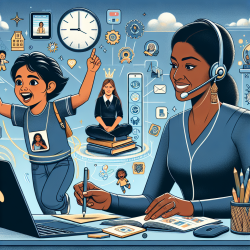Revolutionizing Child Therapy with Technology-Assisted Collaborative Care
In the ever-evolving field of speech-language pathology, the integration of technology into therapeutic practices has been a game-changer. A recent study titled "Technology-Assisted Collaborative Care Program for People with Diabetes and/or High Blood Pressure Attending Primary Health Care: A Feasibility Study" sheds light on the potential of technology-assisted collaborative care (TCC) in managing depression among patients with chronic illnesses. While the study primarily focuses on adults, its implications can be transformative for child therapy, especially in the context of online therapy services like those offered by TinyEYE.
Key Findings of the Study
The study evaluated a TCC program that included a face-to-face, computer-assisted psychosocial intervention, telephone monitoring, and a mobile phone application for behavioral activation. The program showed promising results, with two-thirds of participants achieving a positive response to depression treatment. This was accompanied by a decrease in depressive symptoms and healthcare visits, and an increase in mental health-related quality of life and treatment adherence.
Translating Findings to Child Therapy
While the study's focus was on adults with chronic conditions, the principles of TCC can be adapted to enhance outcomes in child therapy. Here’s how:
- Collaborative Approach: Just as the study emphasized shared responsibilities between mental health specialists and general health teams, child therapy can benefit from a collaborative approach involving parents, educators, and therapists to create a holistic support system for the child.
- Technology Integration: The use of computer-assisted interventions can make therapy sessions more engaging for children, utilizing interactive and multimedia elements to maintain their interest and enhance learning.
- Remote Monitoring: Incorporating telephone or video check-ins can help maintain continuity of care and provide support to parents and children outside of regular therapy sessions.
- Behavioral Activation: Developing mobile applications tailored for children can encourage them to engage in positive activities and track their progress, fostering a sense of accomplishment and motivation.
Encouraging Further Research
While the study provides a solid foundation, further research is needed to tailor these interventions specifically for children. Practitioners are encouraged to explore how technology can be leveraged to address specific challenges in child therapy, such as maintaining engagement and addressing diverse learning needs.
Conclusion
The integration of technology-assisted collaborative care in child therapy holds immense potential for improving therapeutic outcomes. By drawing on the insights from the study, practitioners can innovate and enhance their approaches, ultimately creating better futures for children. For those interested in delving deeper into the original research, please follow this link: Technology-Assisted Collaborative Care Program for People with Diabetes and/or High Blood Pressure Attending Primary Health Care: A Feasibility Study.










